Sharing live video content through your WordPress site is a powerful way to engage with your audience in real time.
Embedding a YouTube live stream allows visitors to watch events, webinars, and special broadcasts directly on your website, improving user interaction and expanding your reach.
At WPBeginner, we recognize YouTube as a powerful platform that can drive significant traffic. That’s why we have created our own channel and regularly post videos to attract more visitors to our blog. This strategy has helped expand our reach and connect with a broader audience.
In this article, we will show you how to easily embed a YouTube live stream in WordPress.
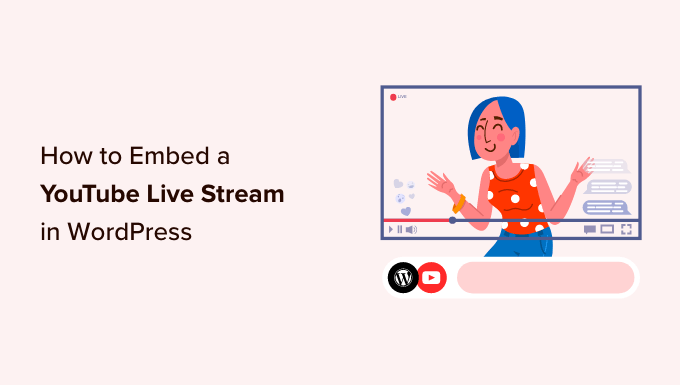
Why Embed YouTube Live Streams in WordPress
Live streaming allows you to broadcast live video or audio content over the internet, enabling users to watch the video in real time.
Embedding a YouTube live stream on your WordPress website is an excellent way to connect with your audience and reach more users.
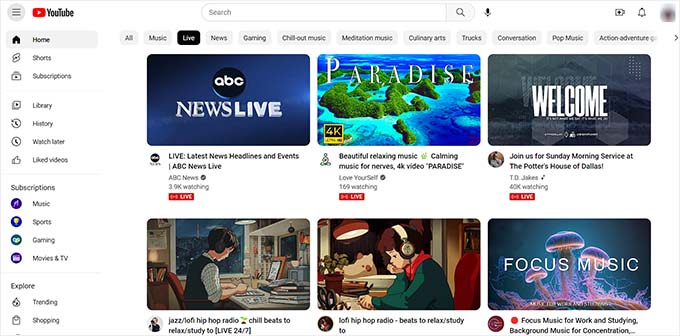
It can also increase user engagement by allowing you to interact with site visitors.
A YouTube live stream can also help boost website SEO and attract more traffic. Research has shown that blog posts with at least one video get around 83% more visitors than content without any.
That being said, let’s see how you can easily embed a YouTube live stream in WordPress.
How to Embed a YouTube Live Stream in WordPress
The easiest way to embed a YouTube live stream is by using Smash Balloon’s YouTube Feed Pro plugin.
It is the best WordPress YouTube plugin on the market that allows you to embed YouTube videos and live streams on your website.
First, you need to install and activate the YouTube Feed Pro plugin. For more instructions, please see our beginner’s guide on how to install a WordPress plugin.
Note: YouTube Feed also has a free version. However, it does not support the Live Stream feature.
Upon activation, visit the Youtube Feed » Settings page from the WordPress admin sidebar. Here, you must enter the license key and click on the ‘Activate’ button.
You can get this information from your account on the Smash Balloon website.
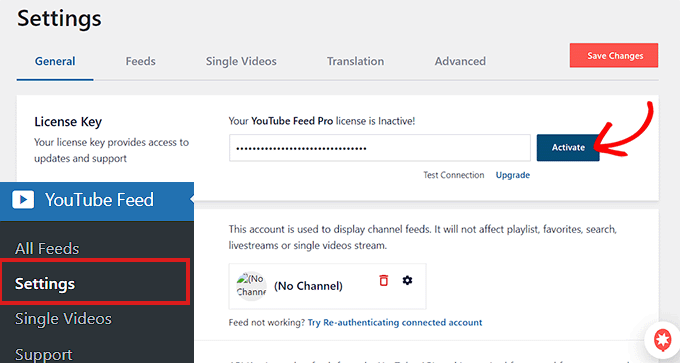
Next, visit the YouTube Feeds » All Feeds page from the WordPress dashboard.
From here, click on the ‘Add New’ button at the top.
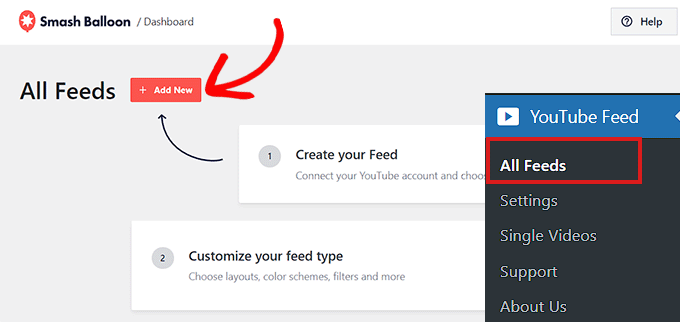
This will open up the ‘Select Feed Type’ prompt on the screen.
To continue, you must select the ‘Live Streams’ option and click the ‘Next’ button.
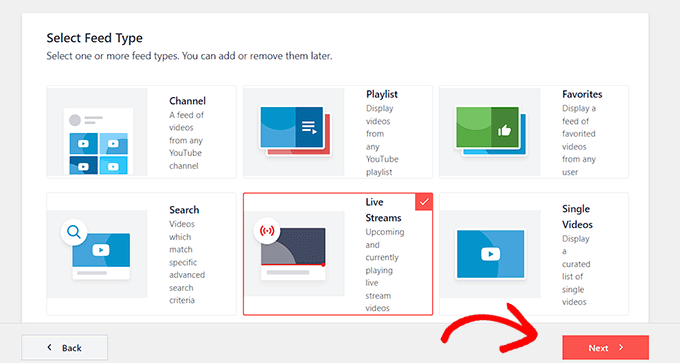
In the next step, you need to connect YouTube Feed Pro with your YouTube account. You will be asked to provide your YouTube API key.
If you already have an API key, simply copy and paste it into the ‘Enter API Key’ box and click on the ‘Add’ button.
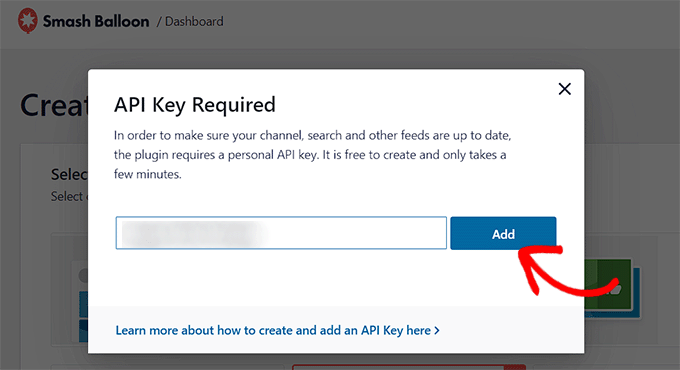
Create a YouTube API Key
If you don’t have an API key yet, then go to the Google Cloud Console and sign in using your Google account.
Once you are logged in, click on the ‘Select a project’ button at the top.
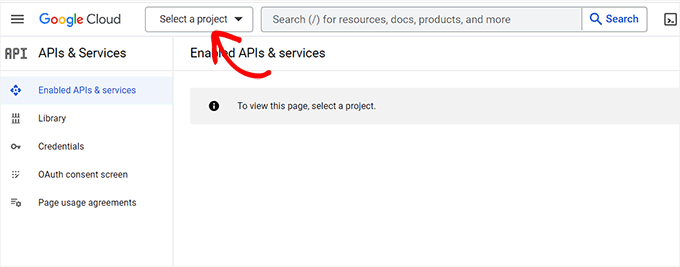
This will open a popup window that will display all the projects that you have created.
Now, click on the ‘New Project’ button at the top right corner.
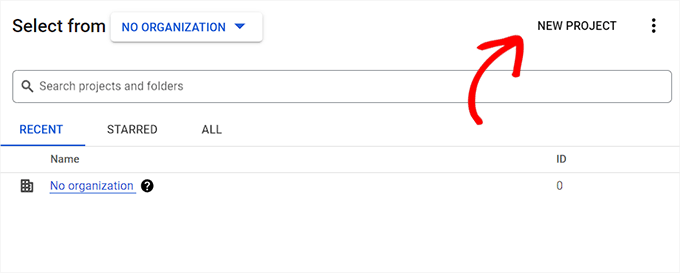
This will take you to the ‘New Project’ page, where you can start by typing in a name for your project. It can be anything that will help you easily identify it.
Next, you must select an ‘Organization’ and its location from the dropdown menu. You can choose ‘No Organization’ and click the ‘Create’ button to continue.
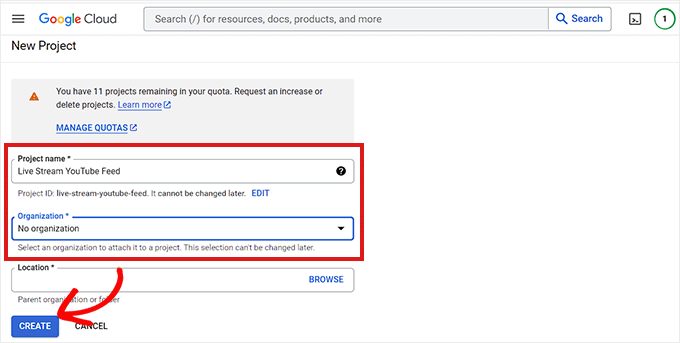
Once the project has been created, you will be taken to the project dashboard.
From here, click on the ‘+ Enable APIs And Services’ button in the top menu.
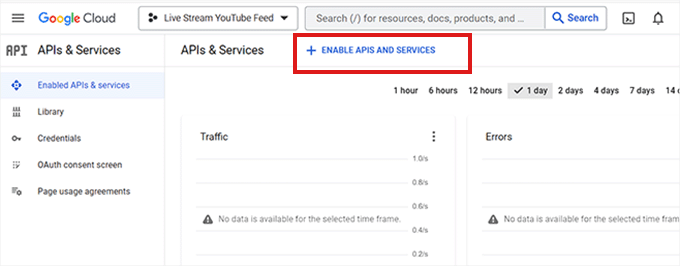
This will take you to the API Library page. It shows the different Google services that you can create APIs for and use in your projects.
Now go ahead and search for ‘YouTube Data API v3’ in the search box.
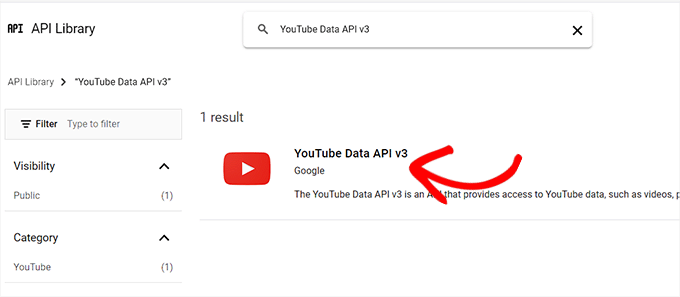
Once the ‘YouTube Data API v3’ result shows up, just click on it.
You will now be directed to a new screen where you need to click on the ‘Enable’ button to activate the YouTube API key.
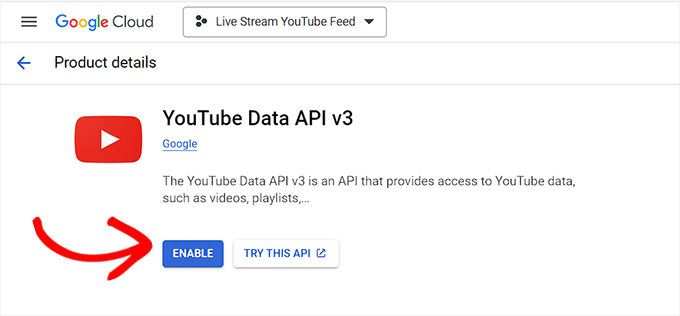
This will take you to the ‘API/Service Details’ page.
From here, click on the ‘Create Credentials’ button at the top.
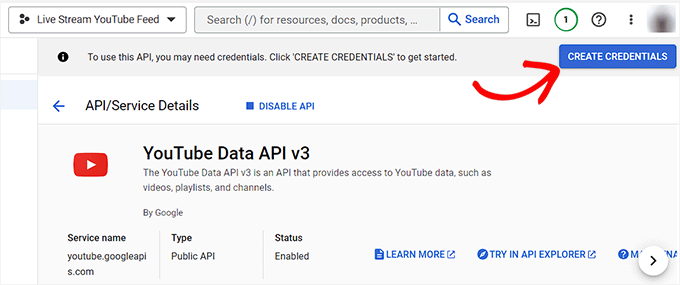
Next, you will be directed to a new page, where you must check the box next to the ‘Public Data’ option.
After that, click on the ‘Next’ button to create your API.
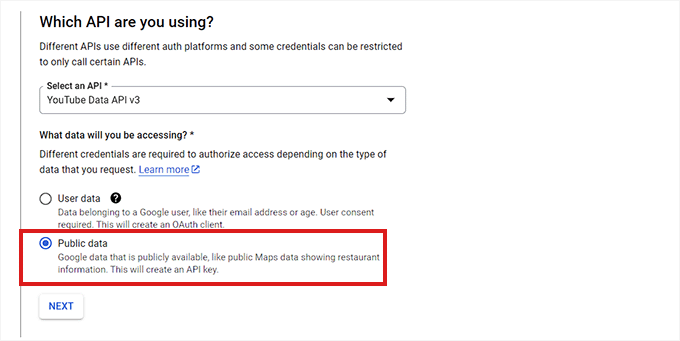
Your API Key will now be created and displayed on the page.
Simply copy this key and click on the ‘Done’ button.
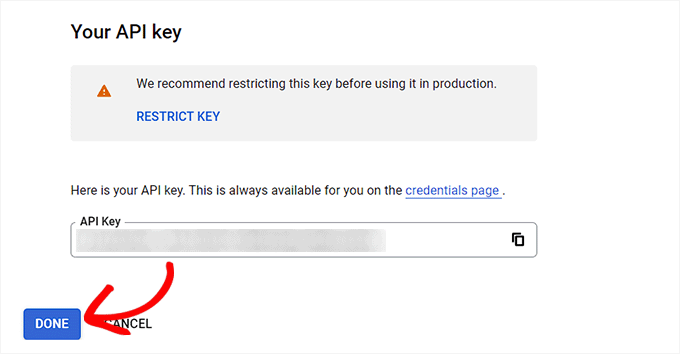
Now, it is time to head back to the WordPress dashboard.
Go ahead and paste the API key into the API Key Required box. Then, click on the ‘Add’ button to continue.

Add the YouTube Live Stream to Your WordPress Website
Once you’ve added your YouTube API key, you will be redirected to the ‘Select Feed Type’ page.
From here, click on the ‘Live Stream’ option again, followed by the ‘Next’ button.
This will open the ‘Add Channel ID For Live Stream’ page.
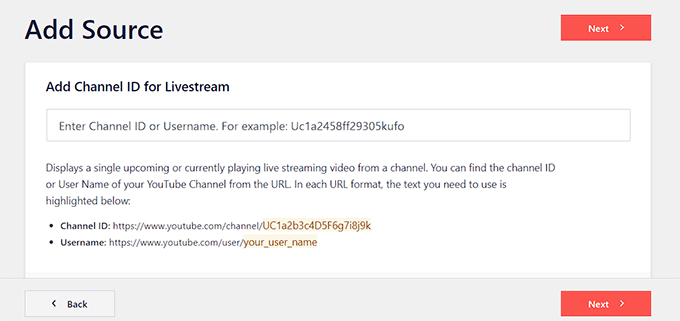
Now, you need to visit the YouTube channel that contains your live-stream videos.
From here, go ahead and copy the text that comes after ‘/channel/’ or ‘/user/’ in the URL at the top.
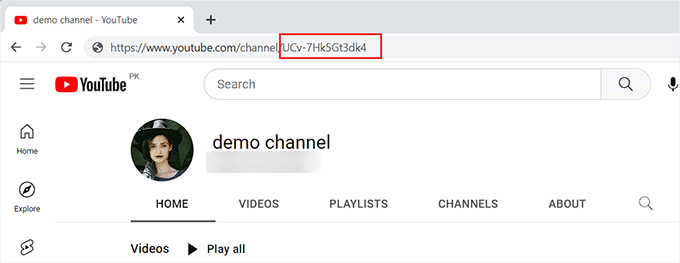
Next, switch back to the WordPress dashboard and paste the code into the ‘Add Channel ID for Livestream’ box.
After that, click on the ‘Connect’ button to connect your YouTube channel with WordPress.
Once the channel is connected, click on the ‘Next’ button to continue.
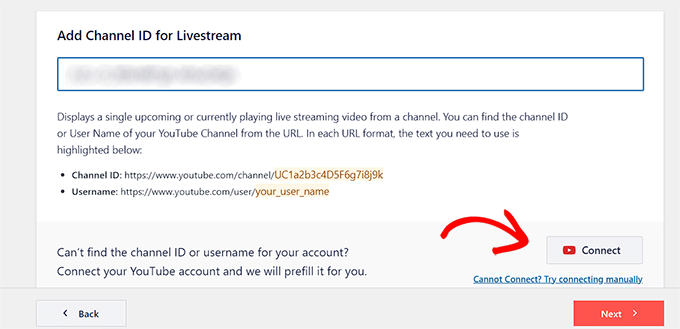
Customize Your YouTube Feed
Now that your YouTube live stream feed has been created, you can customize it. Smash Balloon’s YouTube Feed Pro offers many different display options.
First, you must choose a template on the ‘Start with a template’ page. You can choose from Default, Carousel, Cards, List, Gallery, or Grid layouts.
Once you have made your choice, click on the ‘Next’ button.
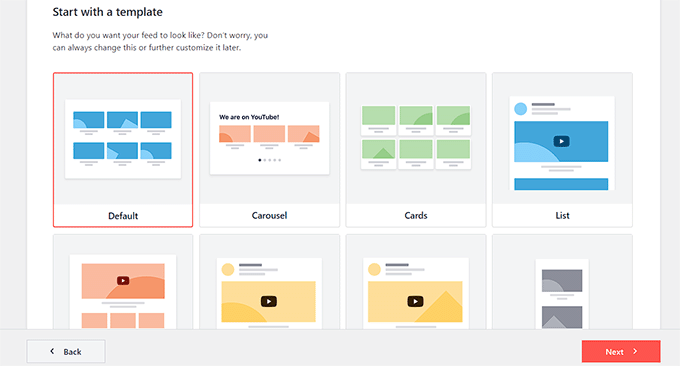
Once you have done that, an editing screen will open up that displays a preview of your YouTube feed to the right and customization settings in the left menu column.
Here, you can start by expanding the ‘Feed Layout’ panel.
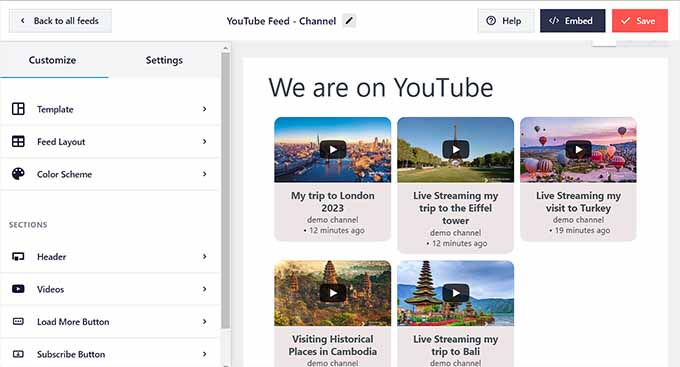
On this screen, you can switch between the layouts.
You may also be able to configure additional settings depending on your chosen layout.
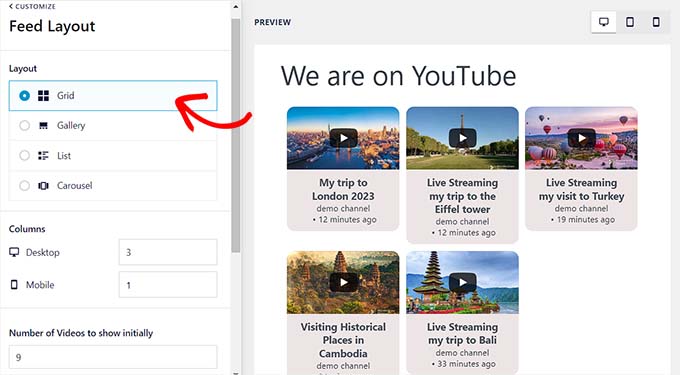
Next, you need to click on the ‘Color Scheme’ panel.
By default, YouTube Feed Pro uses the same color scheme as your WordPress theme. However, you can also use a ‘Light’ or ‘Dark’ color scheme for the video feed.
You can also design your own color scheme by clicking on the ‘Custom’ option and then using controls to change the background, text, and link colors.
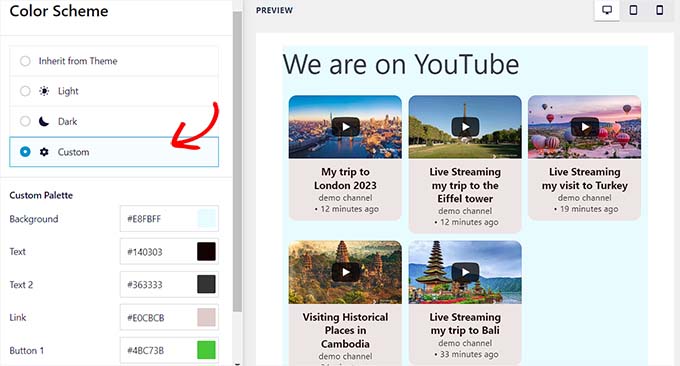
To add a header to your YouTube feed, you need to visit the ‘Header’ panel. From here, toggle the ‘Enable’ switch to activate the header.
You can also use the controls to switch between standard and text header styles. Choosing the ‘Text’ option will allow you to change the text size and color.
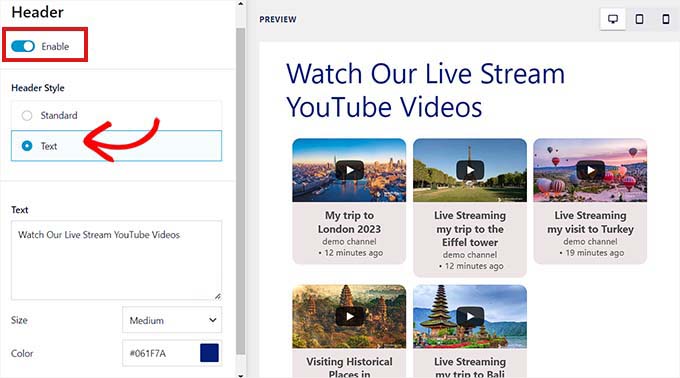
You can also customize the appearance of the video player by going to the ‘Videos’ panel.
Here, you will see a list of options.
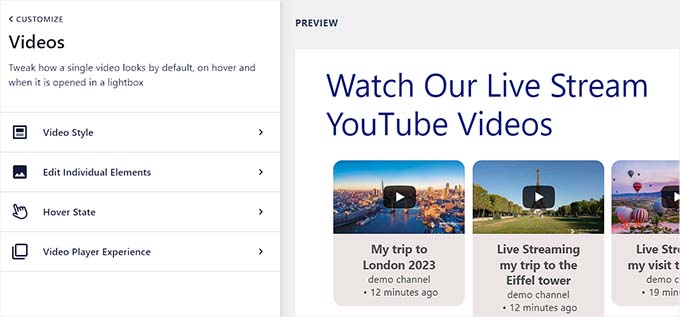
To customize the video layout and individual properties, visit the ‘Video Style’ settings panel.
Here, you can select the video layout, background color, and border.
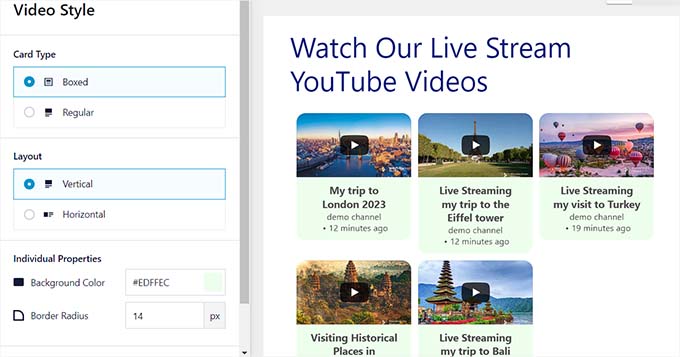
After that, open the ‘Edit Individual Elements’ panel. Here, check the boxes next to the elements you want to display along with the YouTube live-stream videos.
You can show or hide the Play icon, video title, live stream countdown, descriptions, and more.
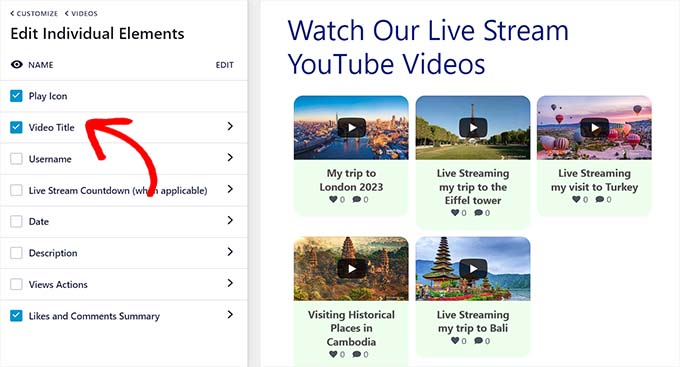
Next, head over to the ‘Hover State’ setting. Here, you can choose the individual elements that will be displayed when the user hovers their mouse over the YouTube video.
You can pick many elements, including video title, description, date, views, and more.
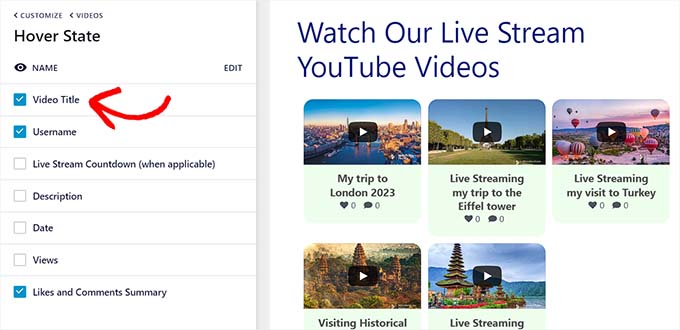
After that, visit the ‘Video Player Experience’ panel.
You can now change the video player’s aspect ratio. You can also choose whether the video will start playing automatically or wait until the visitor clicks the play button.
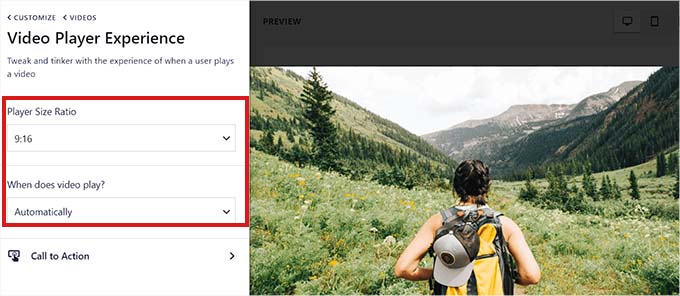
After customizing the individual video elements, switch to the ‘Load More Button’ panel.
Here, under the ‘Load More Button’ setting, you can switch the toggle to ‘Enable.’ This will display more video suggestions after the livestream.
You can also choose the background color, hover state, and text from the settings in the left panel.
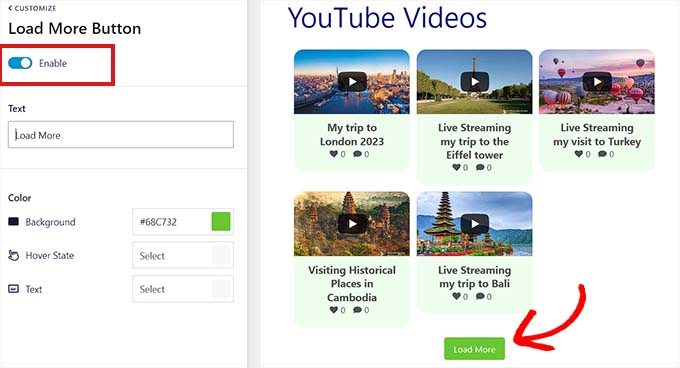
After that, switch to the ‘Subscribe Button’ panel and toggle the switch to ‘Enable’ if you want to activate the YouTube subscribe button.
You can also change the button’s color, text, and hover state in the settings.
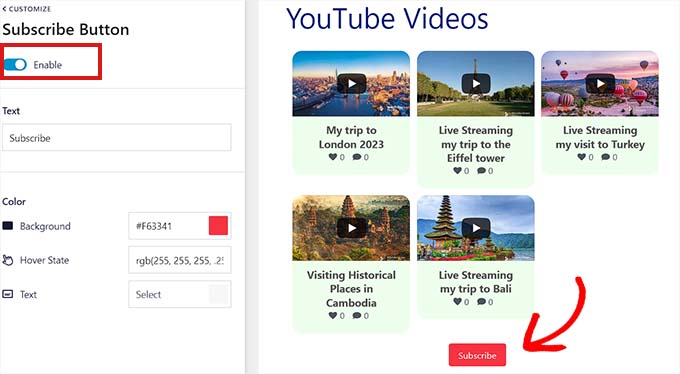
Once you have customized the YouTube live feed, you can preview how it will look on desktop computers, tablets, and smartphones. Simply click on the different buttons in the upper-right corner to preview the feed on different devices.
Finally, don’t forget to click the ‘Save’ button at the top to save your changes.
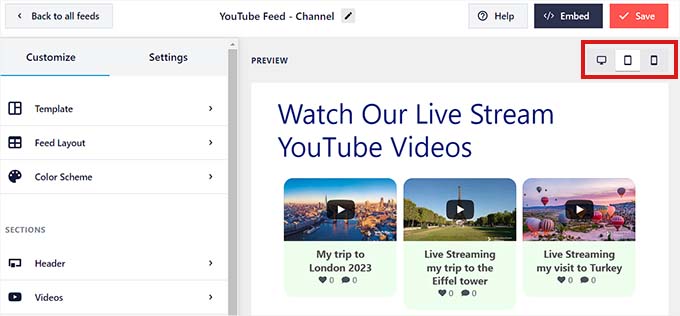
Embed the YouTube Live Stream on a WordPress Page
The next step is to embed your YouTube live feed on a WordPress page. To do this, you must first click on the ‘Embed’ button at the top.
This will open the ‘Embed Feed’ prompt. To continue, click the ‘Add to a Page’ button.
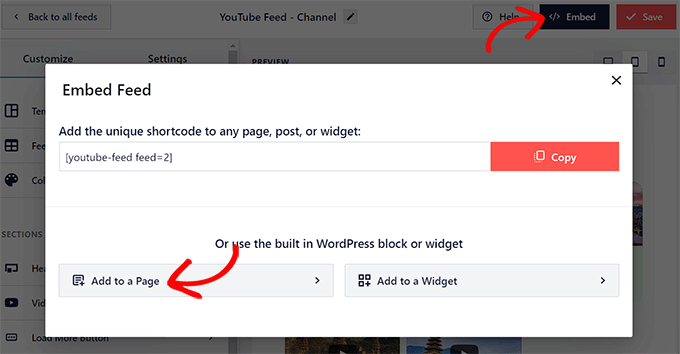
The popup will now show a list of all the WordPress pages on your website.
Simply choose the page where you want to embed the YouTube live stream and click the ‘Add’ button.
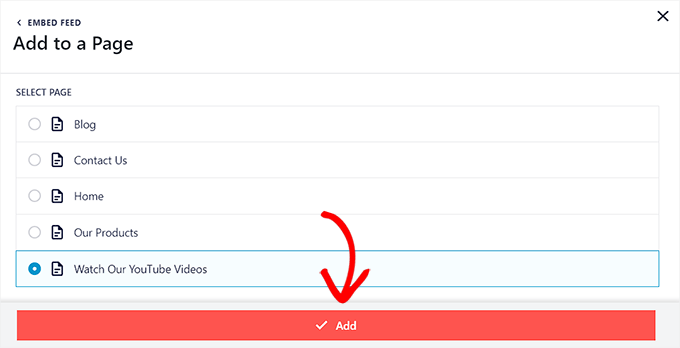
The page you selected will now open up in the block editor.
From here, click the ‘Add Block’ (+) button in the top left corner and search for the Feeds for YouTube block.
Once you find it, you can add the block to your page by clicking on it.
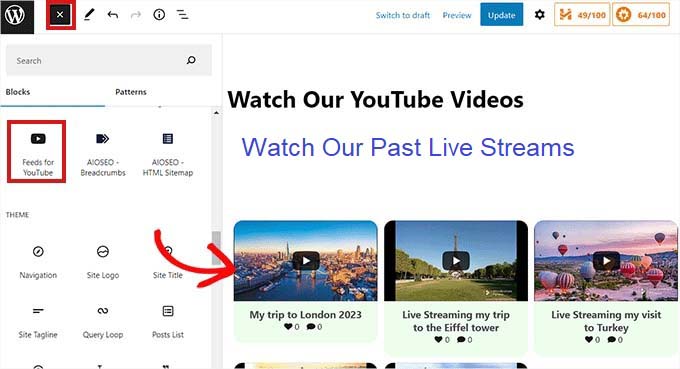
Don’t forget to click on the ‘Update’ or ‘Publish’ button to save your changes or make them live.
This is how the YouTube live feed looks on our demo website.
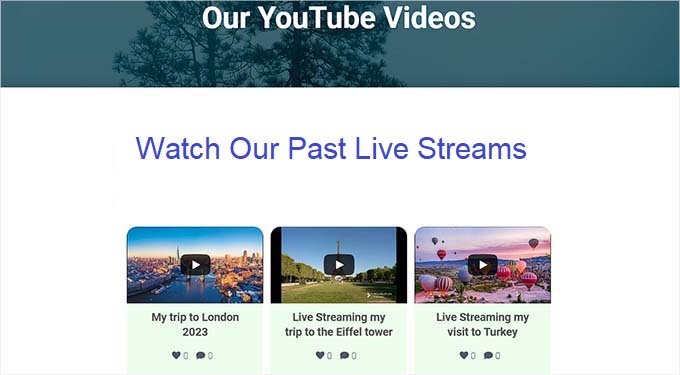
Add a YouTube Live Feed as a Widget
You can also add a YouTube live feed to the WordPress sidebar as a widget.
First, head over to the Appearance » Widgets page from the admin sidebar.
Here, click on the ‘Add Block’ (+) button in the top left corner of the screen and find the Feeds for YouTube block.
Next, click on the block to add it to the widget area.
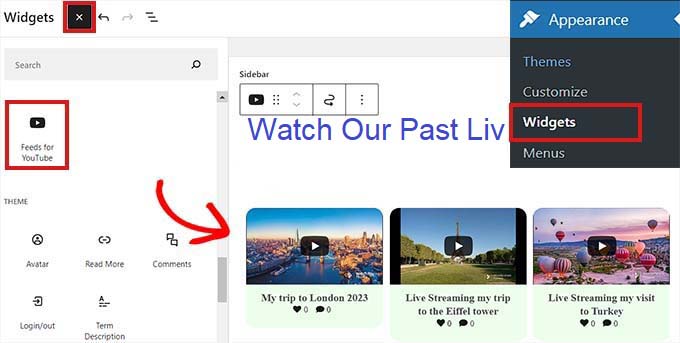
Don’t forget to click on the ‘Update’ button to save your changes.
This is how the YouTube live feed looks in the sidebar on our demo website.
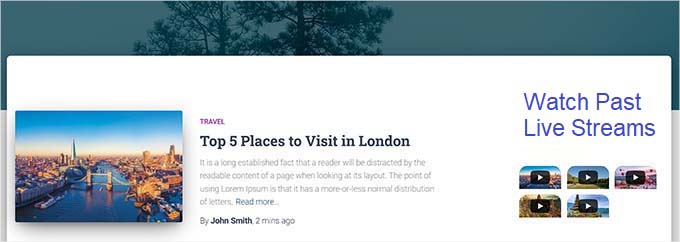
Add a YouTube Live Stream in the Full Site Editor
If you are using a block-based theme, then this method is for you.
First, go to the Appearance » Editor page from the admin sidebar to launch the site editor.
From here, click on the ‘Add Block (+)’ button at the top and look for the Feeds for YouTube block.
Next, you can drag and drop the block to wherever you want to display the YouTube feed on your page.
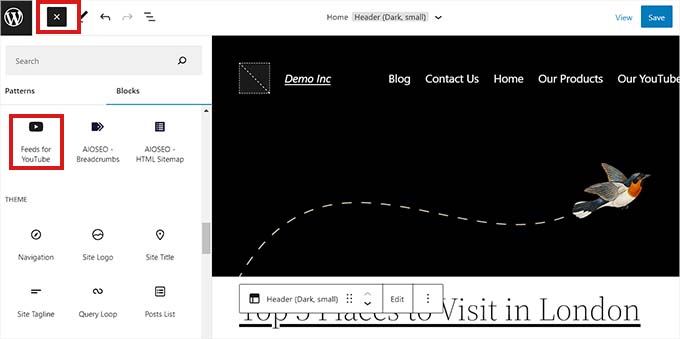
Once you are done, don’t forget to click on the ‘Save’ button to apply the changes.
Here is a preview of the live streams on our demo website.
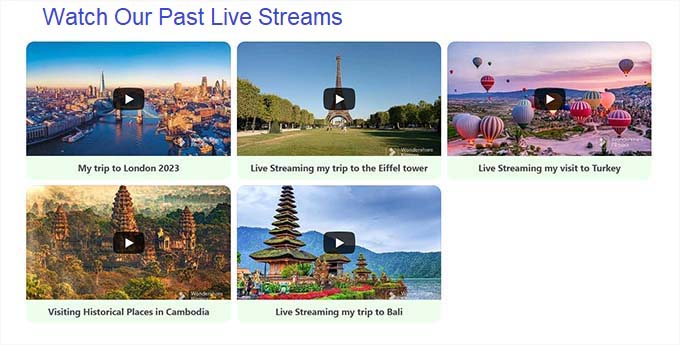
Bonus: Embed a YouTube Playlist in WordPress
Apart from live streams, you can also embed YouTube playlists on your WordPress site with the Smash Balloon YouTube Feed plugin.
You can use this playlist to grab user’s attention, boost engagement, and reduce bounce rates.
To add a YouTube playlist, visit the YouTube Feeds » All Feeds page and click the ‘Add New’ button. This will direct you to a new screen, where you must select the ‘Playlist’ option as the feed type.
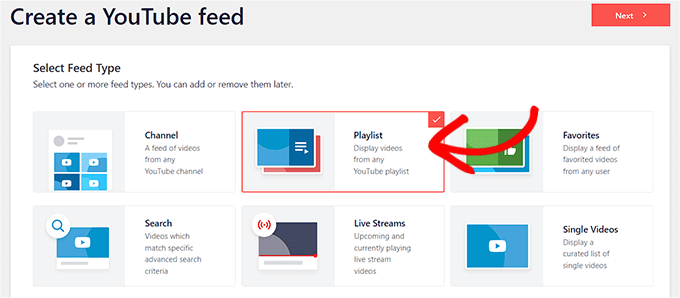
Then, you will need to connect your YouTube account with Smash Balloon by providing its API key from the Google Console.
After that, you must open the YouTube playlist that you want to add and copy its ID from the URL above. This ID will be a string of letters and numbers after the ‘=’ symbol in the URL.
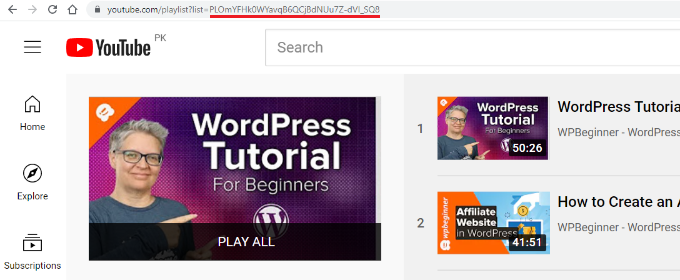
Now, you can visit your WordPress dashboard to add the playlist ID into the ‘Add Source’ field and click the ‘Next’ button.
Once you have done that, Smash Balloon’s feed editor will open up on the screen, where you can customize the playlists’ appearance according to your liking.
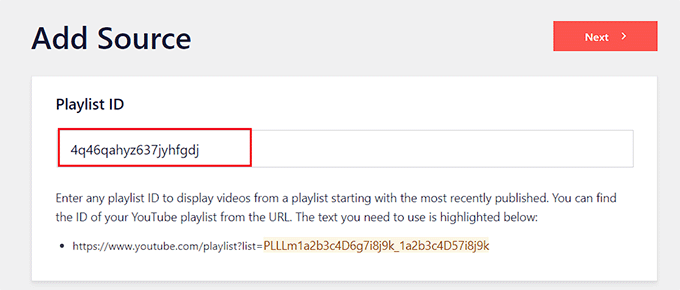
You have now successfully added your YouTube playlist. For more details on this, you can see our tutorial on how to embed a YouTube playlist in WordPress.
We hope this article helped you learn how to embed YouTube live streams in WordPress. You may also want to read our tutorial on how to embed SoundCloud in WordPress posts with oEmbed and our guide on how to embed a discord widget in WordPress.
If you liked this article, then please subscribe to our YouTube Channel for WordPress video tutorials. You can also find us on Twitter and Facebook.





Have a question or suggestion? Please leave a comment to start the discussion.